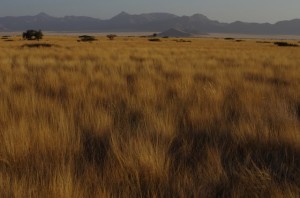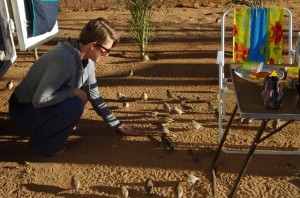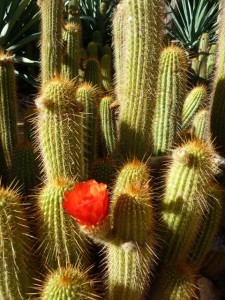After almost two agonizingly long (and hot) weeks in Windhoek, Bruno and I finally hit the road! Our goal? Reaching the Southern border en route to South Africa, while visiting as many interesting Namibian places as possible on the way. This is the essence of Bruno’s travel style – to make the journey the goal itself, rather than simply the destination. It’s a much more enjoyable, albeit slower, way of traveling. If I were doing this route “normally”, I’d already be in Cape Town by now, but I would have missed a lot of interesting Namibian things along the way.
Day 1:
Today we reach Solitaire, a place which embodies its name. Set on the Northern edge of the Namib Desert, the “town” pops up, as if a mirage, out of nowhere. I use quotations here because it is not a town, but merely a hotel, gas station, and bakery, set at the intersection of two “highways”. I use quotations here because the roads are not highways, but merely large, bumpy gravel roads, almost imperceptible from the earth around them. When Bruno started coming here ten years ago, there was no other sign of civilization 150km in any direction, but now… well, you know how tourism goes. Perhaps in a few more years, the “town” will have to change its name.

Solitaire is only 250km from Windhoek, yet it takes us 6 hours to reach it. We leave the tar road a few kilometers outside of the city, and take potholed back roads to get here. Another Bruno travel choice, allowing us to see stretches of uninhabited landscape and making us feel as though we have left civilization behind us and have embarked on a journey into the wild, desolate landscape of the Namib. Our vehicle put-putts slowly up the hills, to over 2000m in elevation, where the rolling hills are green (as green as I’ve seen Namibia, at least, which isn’t saying much), and then back down to a barren, yellow-tinted land dotted with craggy peaks reminiscent of the mountains of the Sinai Peninsula. Solitaire is beautiful because it is a flatland entirely surrounded by these peaks.

As the sun sets behind the mountains, Bruno and I spot some creatures running through our campsite. Upon closer investigation, they turn out to be a family of genets scurrying for a tree. We stand under this tree for quite a while investigating the family, and they investigate us back. They are so cute – their faces look catlike, with long, bushy tails striped in black and white. They remind me of meercats, which also live here, and which I hope to see in the coming days. (After seeing the documentary, “Meercats”, I am mildly obsessed with them. If you haven’t seen the film, you have to!)
Day 2:
We have decided to spend the day in Solitaire in order to explore the area a bit and allow me to rest, as I’m still not feeling 100%. After breakfast, where I feed a group of 50 birds bread crumbs from my hand, I go for a short exploratory walk. I interrupt a male peacock in the middle of his flirtatious dance with a female, where he shakes his butt (including his anus and back feathers) and stretches out his turquoise fan in order to woo his potential mate. She is not impressed. I pass by a few geese, who follow me around for a while, honking some kind of indecipherable message at me. I see beautiful red flowers on cacti, which open up for the daylight and close up in the cold of night.
Then it gets hot. I can’t be in the sun, even with 55spf! Even the shade is hot, the breeze is hot, everything is hot. The answer? Swimming pool! I spend the entire afternoon there, reading a fabulous book (“Tales of a Females Nomad”), and taking frequent dips in the pool. The only time I leave the swimming pool before dusk is to eat the famous apple pie at Solitaire’s bakery. Ahhhh, life is rough!
To top off my rough afternoon, just before sunset (which I watch as it dips behind the now purplish peaks), I see a family of meercats scurry off into the bushes! I don’t see them long or from very close (boy, do these shy creatures ever run fast!), but my growing obsession is temporarily satiated nonetheless!
Day 3:
Today we head 200km south to Duwisib Castle, just east of Betta. The drive starts off well, as we pass through the beautiful Naukluft Mountains to the sounds of Bob Marley. The breeze, however, quickly turns hot, and the sun beats through the glass, leaving me sweaty and red. Bruno and I compulsively spray water at ourselves through garden spray bottles to temporarily relieve our discomfort.

Duwisib Castle is a strange place. Built in 1908 by a German ex-military man and his millionaire wife, I wonder, as I walk through it, why they would choose here of all places to build their home. It’s in the middle of nowhere, it’s hot as blazes, and it’s not even in a particularly stunning locale. Whatever their reason, they live here in wealth and luxury, breeding purebred horses, for only five years. War has begun in Europe, so they head back to Germany, where he rejoins the army and soon dies. She never returns to Namibia, and the castle lays abandoned for years before being purchased by the Namibian government as a heritage home.
In front of the castle is a gorgeous Kockerboom tree, the national emblem of Namibia. A fairly short tree with interesting bark that peels off in smooth sections and leaves that sort of remind me of a palm tree, we have seen this emblem dotted across the landscape throughout our trip south. Always standing alone on otherwise barren hills, it is obviously well-adapted to the dry land and brutally strong sun. You must be both of these things in order to live in Namibia, so it is a fitting emblem.
Tonight, we camp beside the castle and watch as the setting sun leaves a romantic red glow on the castle. The stars are gorgeous in this place, unpolluted by unnatural light.
Day 4:
 225km today, 5.5 hours. We’re just outside of a little town called Aus, amid a different type of Namibian mountain, shaped by boulders. In the shade, it’s nice and cool, as the wind is coming from the ocean, 125km away. Ahh, fresh cool breeze, how I’ve missed you!
225km today, 5.5 hours. We’re just outside of a little town called Aus, amid a different type of Namibian mountain, shaped by boulders. In the shade, it’s nice and cool, as the wind is coming from the ocean, 125km away. Ahh, fresh cool breeze, how I’ve missed you!It’s Bruno’s birthday today, and he gets an amazing birthday treat – a morning of wildlife spotting on the road to Aus! First we see steenbok, tiny antelope with rabbit-like ears. Then, we almost hit a cobra that sticks its head aggressively in the air at us in retaliation. We also almost hit an oryx (also called ‘gemsbok’) crossing the road. Later on we see a herd of oryx frantically crashing into fences as they desperately try to escape us. Bruno says they must be hunted in this area, for there is no other reason for them to be so nervous. That saddens me, as these antelope are particular beautiful – they have a black and white face, black stripes along their stomach and legs, and long, straight, incredibly pointy horns.
During our drive, we also spot loads of springbok, aptly named for the ‘spring’ in their jump. We amuse ourselves honking the horn at them to see them elegantly spring into the air as they speedily race off. In Southern Africa, the springbok is nicknamed ‘lion meat’, but as I watch them gracefully maneuver the landscape, I can’t imagine them ever being caught.
 Our campsite is idyllically located underneath a massive communal birds’ nest, one of many that we have admired in the last few days. The largest nest we’ve spotted was earlier today, and it was no less than 10 meters long! These nests house tiny yellowish-brown birds called “Social Republicans”; social because these nests are communal, housing hundreds of these birds. There are lots of tiny entrance holes at the bottom of the nests, leading into corridors and individual rooms for bird families. Here, they sleep, keep their eggs, and take care of their young. The coolest thing about these nests? They maintain a constant temperature of about 20 degrees, regardless of outside temperature. Pretty practical in the desert, eh? They should give out these nests as sleeping bags at the arrivals’ gate of the Windhoek airport!
Our campsite is idyllically located underneath a massive communal birds’ nest, one of many that we have admired in the last few days. The largest nest we’ve spotted was earlier today, and it was no less than 10 meters long! These nests house tiny yellowish-brown birds called “Social Republicans”; social because these nests are communal, housing hundreds of these birds. There are lots of tiny entrance holes at the bottom of the nests, leading into corridors and individual rooms for bird families. Here, they sleep, keep their eggs, and take care of their young. The coolest thing about these nests? They maintain a constant temperature of about 20 degrees, regardless of outside temperature. Pretty practical in the desert, eh? They should give out these nests as sleeping bags at the arrivals’ gate of the Windhoek airport!We watch the birds noisily fly in and out of their nest, flapping their wings like hummingbirds in order to fly vertically into their nests. As the sun sets on our tranquil campsite, the birds slowly quiet as they tuck in for another cozy night together. We do the same.
Day 5:
 A short drive today, 125km to Luderitz. And this time on a tarred road! How luxurious! Shortly after leaving Aus, we enter the restricted “Diamond 1” area (more on this area in another blog entry), where feral horses endemic to this area roam freely. These horses are adapted to desert living, as they pee less than regular horses, are slightly smaller, and can go up to 5 days without water! No one knows exactly where they came from, and they are certainly not originally from the region; perhaps they came during the war with South Africa or with the German colonials, or perhaps from an Australian-bound ship wrecked off the coast, or even from Duwisib Castle! What we do know is that their lineage is purebred, and that they have slowly developed the ability to live in this harsh climate. Amazing!
A short drive today, 125km to Luderitz. And this time on a tarred road! How luxurious! Shortly after leaving Aus, we enter the restricted “Diamond 1” area (more on this area in another blog entry), where feral horses endemic to this area roam freely. These horses are adapted to desert living, as they pee less than regular horses, are slightly smaller, and can go up to 5 days without water! No one knows exactly where they came from, and they are certainly not originally from the region; perhaps they came during the war with South Africa or with the German colonials, or perhaps from an Australian-bound ship wrecked off the coast, or even from Duwisib Castle! What we do know is that their lineage is purebred, and that they have slowly developed the ability to live in this harsh climate. Amazing!
As we enter Luderitz, we breathe in our first breaths of fresh ocean air, and I smile. Gone are the days of desert heat, bring on that Atlantic ocean cool! Yippee!!!!!!
Perhaps I speak too soon, for as we reach our campsite, “Shark Island”, on the tip of the Luderitz Peninsula, the gale wind almost knocks me over, and our camping car rocks back and forth in the wind all night long, as though we are out at sea!






 225km today, 5.5 hours. We’re just outside of a little town called Aus, amid a different type of Namibian mountain, shaped by boulders. In the shade, it’s nice and cool, as the wind is coming from the ocean, 125km away. Ahh, fresh cool breeze, how I’ve missed you!
225km today, 5.5 hours. We’re just outside of a little town called Aus, amid a different type of Namibian mountain, shaped by boulders. In the shade, it’s nice and cool, as the wind is coming from the ocean, 125km away. Ahh, fresh cool breeze, how I’ve missed you! Our campsite is idyllically located underneath a massive communal birds’ nest, one of many that we have admired in the last few days. The largest nest we’ve spotted was earlier today, and it was no less than 10 meters long! These nests house tiny yellowish-brown birds called “Social Republicans”; social because these nests are communal, housing hundreds of these birds. There are lots of tiny entrance holes at the bottom of the nests, leading into corridors and individual rooms for bird families. Here, they sleep, keep their eggs, and take care of their young. The coolest thing about these nests? They maintain a constant temperature of about 20 degrees, regardless of outside temperature. Pretty practical in the desert, eh? They should give out these nests as sleeping bags at the arrivals’ gate of the Windhoek airport!
Our campsite is idyllically located underneath a massive communal birds’ nest, one of many that we have admired in the last few days. The largest nest we’ve spotted was earlier today, and it was no less than 10 meters long! These nests house tiny yellowish-brown birds called “Social Republicans”; social because these nests are communal, housing hundreds of these birds. There are lots of tiny entrance holes at the bottom of the nests, leading into corridors and individual rooms for bird families. Here, they sleep, keep their eggs, and take care of their young. The coolest thing about these nests? They maintain a constant temperature of about 20 degrees, regardless of outside temperature. Pretty practical in the desert, eh? They should give out these nests as sleeping bags at the arrivals’ gate of the Windhoek airport! A short drive today, 125km to Luderitz. And this time on a tarred road! How luxurious! Shortly after leaving Aus, we enter the restricted “Diamond 1” area (more on this area in another blog entry), where feral horses endemic to this area roam freely. These horses are adapted to desert living, as they pee less than regular horses, are slightly smaller, and can go up to 5 days without water! No one knows exactly where they came from, and they are certainly not originally from the region; perhaps they came during the war with South Africa or with the German colonials, or perhaps from an Australian-bound ship wrecked off the coast, or even from Duwisib Castle! What we do know is that their lineage is purebred, and that they have slowly developed the ability to live in this harsh climate. Amazing!
A short drive today, 125km to Luderitz. And this time on a tarred road! How luxurious! Shortly after leaving Aus, we enter the restricted “Diamond 1” area (more on this area in another blog entry), where feral horses endemic to this area roam freely. These horses are adapted to desert living, as they pee less than regular horses, are slightly smaller, and can go up to 5 days without water! No one knows exactly where they came from, and they are certainly not originally from the region; perhaps they came during the war with South Africa or with the German colonials, or perhaps from an Australian-bound ship wrecked off the coast, or even from Duwisib Castle! What we do know is that their lineage is purebred, and that they have slowly developed the ability to live in this harsh climate. Amazing!


